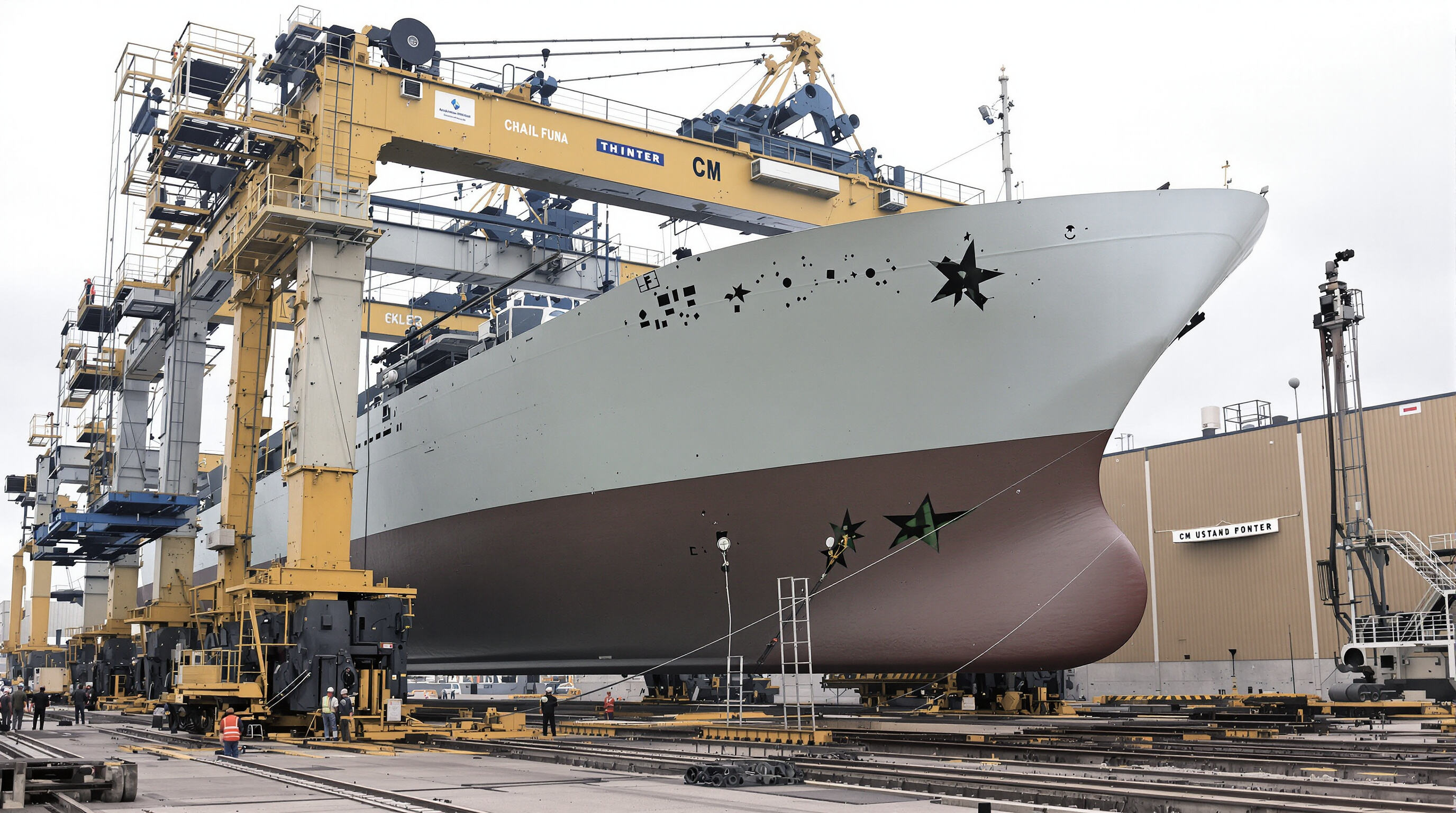Heavy-Duty Gantry Crane Applications in Shipbuilding and Structural Assembly

In shipyards across the globe, gantry cranes play a vital role when it comes to putting together massive parts like hull sections that can weigh as much as 500 tons along with those heavy engine blocks. The way these machines are built on rails allows them to position loads exactly where they need to go, something that matters a lot during delicate welding work. According to recent data from the Maritime Construction Report released in 2023, this precision cuts down on mistakes during assembly by around 23% compared to older techniques. Most models come with solid base structures but their spans can be adjusted anywhere between 20 and 100 meters depending on what the job requires. This flexibility makes them well suited for different layout needs while handling all those frequent lifts that characterize today's ship construction projects.
Key Roles of Gantry Cranes in Construction Site Logistics and Material Handling

At tall building construction sites, those big gantry cranes move massive steel beams weighing up to 300 tons as well as pre-made modules between different parts of the site. Some research from last year showed these cranes actually boost how much stuff gets moved around by about 40% compared to regular truck mounted cranes when working on high rises. What makes them really useful is their ability to handle two jobs at once too. For instance, while placing concrete panels somewhere, they can also grab some rebar for another spot nearby. This means less time wasted waiting for the crane to move back and forth between tasks.
Comparative Advantage Over Mobile Cranes in Fixed-Site Operations
For repetitive lifts in fixed locations, gantry cranes offer 30% higher energy efficiency than mobile cranes and maintain load stability in winds up to 13.8 m/s. Their integrated infrastructure supports automation through programmable trolley paths, making them ideal for precision-critical applications such as nuclear containment vessel installations.
Evaluating Load Capacity, Span, and Lifting Height for Optimal Performance
Selecting the right gantry crane requires balancing three core parameters: load capacity, span, and lifting height. These factors directly influence safety, efficiency, and long-term cost performance in both shipbuilding and construction environments.
Matching Lifting Capacity (20–500 Tons) to Project-Specific Demands
Capacity selection isn't just about hitting those max weight numbers on paper. Real world applications throw in all sorts of variables like dynamic forces during movement, stress from acceleration, plus what happens if the project grows bigger down the road. Take those 300 ton vessel parts for instance. Most folks in the business will tell you to build in around 25% extra capacity because of how things swing around and distribute weight unevenly. When we get into really heavy stuff like those 500 ton bridge components, standard equipment just won't cut it. These jobs demand special engineering work, often with backup braking systems built right in. The math gets complicated fast when dealing with such massive loads.
Maximizing Site Coverage Through Strategic Span Design and Footprint Optimization
Span length plays a crucial role in optimizing material flow, especially on confined or irregular sites. Case studies from 2023 show that a 100-meter span gantry crane at a modular construction facility reduced material relocation time by 40%. Engineers optimize track layout by evaluating:
| Design Factor | Operational Impact |
|---|---|
| Column spacing | Compatibility with existing infrastructure |
| Girder overhang | Edge-area accessibility |
| Track curvature | Multi-directional workflow support |
Ensuring Adequate Lifting Height and Clearance for Multi-Level and Obstructed Environments
Getting enough vertical space is really important when dealing with both existing obstacles and ones that might show up later. A particular shipyard actually boosted their productivity by around 18 percent when they raised their crane hooks four whole meters higher so they could handle those big Panamax ships properly. For places along the coast, most facilities install cranes with adjustable lifting heights because tides go up and down all day long. Meanwhile in city areas where space is limited, many construction teams rely on laser guided equipment to maneuver through complex steel structures without damaging anything. The tolerances here are super tight sometimes as small as just 15 centimeters between components.
Girder Configuration and Structural Design: Single vs. Double Girder Systems
Double Girder Gantry Cranes: Advantages in Load Capacity and Structural Stability
When it comes to heavy lifting tasks, double girder cranes just do better than their single beam counterparts. These machines can handle weights well over 20 tons while staying stable enough for serious work. What makes them so good? Well, they have two beams instead of one which spreads the load around more evenly. This means less bending and flexing when something gets lifted, especially important stuff like parts of ships or big pieces of buildings. Another advantage is that these cranes sit higher off the ground, giving workers more vertical space to maneuver hooks between different levels in busy shipyard environments. According to some recent research from last year, companies using double girder systems saw a pretty impressive drop in accidents caused by swinging loads - about 42 percent fewer incidents overall in places where really heavy things need to be moved regularly.
Truss Gantry Cranes for Long Spans and Reduced Deflection
When dealing with spans over 65 feet long, truss configured gantry cranes actually give better rigidity and weigh about 18 to 22 percent less than those box girder models. The reason? Their triangular lattice structure fights against vertical bending when loads are applied, which keeps things precise during steel work and bridge building projects. Speaking of environments, these truss systems perform much better in coastal regions where rust is a bigger problem. Salt water really takes its toll on structures, causing them to degrade about three times faster than what happens inland. So for places near the ocean, this corrosion resistance makes all the difference in maintenance costs and lifespan.
Performance Comparison: Single vs. Double Girder Systems in Real-World Applications
| Metric | Single Girder | Double Girder |
|---|---|---|
| Typical Capacity | â¬20 tons | 20–500+ tons |
| Hook Height | 8–15 meters | 15–30 meters |
| Installation Cost | $25k–$80k | $50k–$200k+ |
| Operational Lifespan | 15–20 years (A4 duty) | 25–35 years (A6 duty) |
While single girder cranes suit light-duty tasks, double girder systems dominate continuous-use settingsâ80% of shipyards performing lifts above 50 tons have standardized on double girder configurations since 2020.
When Does Added Robustness Justify Higher Costs? Evaluating Cost-Performance Trade-offs
The 30–50% higher initial cost of double girder cranes becomes justified when operations involve:
- More than 50 lifting cycles per day
- Multi-shift production schedules
- Exposure to corrosive marine environments
Suppliers report a 7–10 year return-on-investment break-even point in high-utilization scenarios, with maintenance costs 18% lower over 15 years compared to retrofitted single girder systems. For infrequent useâless than 10-ton lifts fewer than 30 hours weeklyâsingle girder models deliver better value, as confirmed by a recent material handling study.
Durability and Working Duty Classification in Harsh Industrial Environments
Crane Working Duty Classification (A5–A7) and Impact on Lifecycle Cost
The duty classification system basically tells us how hard equipment will be worked: Class A5 means it's built for regular usage while A7 is meant for non-stop operation. Getting this right matters a lot because these ratings have a big impact on both how long machines last and what they'll ultimately cost over time. Looking at actual numbers from field operations, we find that A7 rated cranes typically end up costing somewhere between 20 to 35 percent more across their entire lifespan compared to A5 units. But there's a tradeoff here too since those heavier duty models can produce about 40% more output when needed most, which explains why many shipyards still go with them despite the extra expense according to the Industrial Machinery Report published last year. Making sure equipment gets properly classified isn't just paperwork it's really about finding that sweet spot where machines can handle tough jobs without breaking the bank in maintenance costs down the road.
Robust Construction for Corrosion Resistance in Shipyard and Coastal Conditions
Marine-grade gantry cranes utilize hot-dip galvanized steel frames and epoxy-polyurethane hybrid coatings to resist salt spray corrosion. Critical components such as wire ropes and electrical enclosures incorporate stainless steel alloys and IP66-rated seals, cutting weather-related downtime by up to 70% in coastal installations versus standard designs.
Maintenance Strategies for Prolonged Service Life in Continuous-Operation Sites
Proactive maintenance extends service life by 30–50% in 24/7 operations:
- Predictive monitoring: Vibration sensors detect bearing wear 6–8 weeks before failure
- Corrosion management: Bi-annual ultrasonic thickness testing on load-bearing members
- Load cycle tracking: Electronic hoist meters trigger component replacements at 80% of rated intervals
A 2023 port authority study found these practices reduced unplanned downtime by 58% and preserved 92% of original load capacity after 15 years.
Selecting a Trusted Supplier: Customization and Support with Wuhan Rayvanbo
Supplier Evaluation Criteria: Technical Support, Customization, and Global Reliability
Choosing the right gantry crane supplier means looking for companies that provide solid technical support and can adapt their engineering solutions to specific needs. Good suppliers know their stuff when it comes to analyzing structural loads and making customizations based on site conditions. For example, they might recommend special materials that resist corrosion if the cranes will be used near saltwater environments. They also stick to important international quality standards such as ISO 9001 certification. Don't forget to check where the company operates globally because this affects how quickly replacement parts arrive and whether technicians can show up on site when needed, reducing downtime for businesses. Recent data shows something interesting too: according to a survey done last year among shipyard workers, around two thirds of all equipment breakdowns happened because the cranes weren't rated properly for what they were actually doing day to day. That's why matching crane specs exactly to real world requirements remains so critical.
Global Case Studies: Successful Gantry Crane Deployments
Shipbuilders in the Baltic have seen their hull assembly times drop around 18% when they switch to modular gantry systems, thanks to better span setups and how weight gets distributed across two girders. Over in Southeast Asia, one construction company had trouble working on tight city sites until they brought in those adjustable height gantry cranes. They managed to clear obstacles vertically about 95% of the time, which made a huge difference for their operations. What these results really show is that good crane suppliers understand both local conditions and need to scale production up or down. When manufacturers know what works where, they can actually fit their equipment into all sorts of complicated building projects without causing headaches for everyone involved.
FAQ
What is a gantry crane?
A gantry crane is a type of crane that runs on a rail system and is used for lifting heavy loads. It is commonly used in shipbuilding and construction for precisely positioning large components.
Why are gantry cranes preferred in shipyards?
Gantry cranes are favored for their precision positioning and ability to handle heavy loads like hull sections and engine blocks, reducing assembly mistakes.
How do gantry cranes compare to mobile cranes?
Gantry cranes offer higher energy efficiency and load stability in winds, making them suitable for fixed-site operations.
Table of Contents
- Heavy-Duty Gantry Crane Applications in Shipbuilding and Structural Assembly
- Key Roles of Gantry Cranes in Construction Site Logistics and Material Handling
- Comparative Advantage Over Mobile Cranes in Fixed-Site Operations
- Evaluating Load Capacity, Span, and Lifting Height for Optimal Performance
-
Girder Configuration and Structural Design: Single vs. Double Girder Systems
- Double Girder Gantry Cranes: Advantages in Load Capacity and Structural Stability
- Truss Gantry Cranes for Long Spans and Reduced Deflection
- Performance Comparison: Single vs. Double Girder Systems in Real-World Applications
- When Does Added Robustness Justify Higher Costs? Evaluating Cost-Performance Trade-offs
- Durability and Working Duty Classification in Harsh Industrial Environments
- Selecting a Trusted Supplier: Customization and Support with Wuhan Rayvanbo
- FAQ



